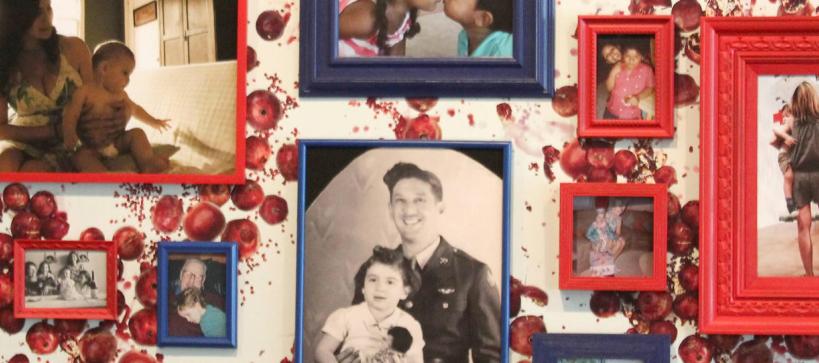
Fallen Fruit (David Burns and Austin Young), Pomegranate Wallpaper (Skirball edition), 2014
Dimensions variable
Fallen Fruit of the Skirball
May 13–October 12, 2014

Fallen Fruit (David Burns and Austin Young), Pomegranate Wallpaper (Skirball edition), 2014
Dimensions variable
May 13–October 12, 2014
This exhibition was on view at the Skirball
May 13–October 12, 2014
For this exhibition, Los Angeles art collaborative Fallen Fruit (David Burns and Austin Young) and the Skirball Cultural Center came together to produce an immersive art installation that celebrated Jewish heritage, relationships, and love.
Fallen Fruit’s name is derived from a passage in the book of Leviticus: “When you reap the harvest of your land, you shall not reap all the way to the edges of your field, or gather the gleanings of your harvest. You shall not pick your vineyard bare, or gather the fallen fruit of your vineyard; you shall leave them for the poor and the stranger.” Fallen Fruit’s community-based projects use fruit as a medium to explore social engagement. The themes of generosity and sharing that guide their work align with the Skirball’s mission of hospitality, equality, and civility.
After studying the Skirball’s collection of Jewish cultural artifacts, Burns and Young found inspiration for their project in a seventeenth-century ketubbah (marriage contract). They also discovered how prominently the pomegranate figures in Jewish tradition, particularly as a symbol of fertility and marriage. Focused on this fruit, the artists researched the emotional, cultural, and intellectual “ingredients that make for a great relationship” during the course of their residency at the Skirball. The resulting exhibition combined their interest in both the cultural ritual of marriage and the beauty of the pomegranate by featuring specially designed wallpaper created from photographs of pomegranate fruits and trees in Southern California. The last addition was a selection of portraits of people who love each other, accompanied by a Love Score—an artfully designed composite of love advice submitted by the public.
Fallen Fruit is an art collaboration originally conceived in 2004 by David Burns, Matias Viegener, and Austin Young. Since 2013, David Burns and Austin Young have continued the collaborative work.
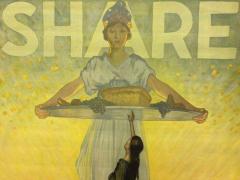
When Los Angeles art collaborative Fallen Fruit (David Burns and Austin Young) investigated the Skirball’s permanent collection of Jewish cultural artifacts, many objects caught their eye. Because their work aims to reconfigure the relationship of sharing and explore understandings of public and private, this Jewish Relief Campaign poster—made in the spirit of giving to those in need after the outbreak of World War I—appealed to them.
Purchase made possible by Peachy and Mark Levy Project Americana Acquisition Fund. SCC66.2768
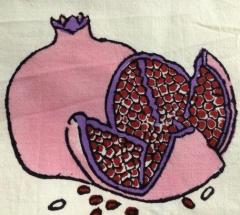
Fallen Fruit uses fruit as a filter to explore social engagement, so the many objects in the collection that feature fruit were of interest. This cloth, decorated with fruit motifs such as etrogs and pomegranates, was originally used to hang in a sukkah, a temporary structure constructed for the Jewish harvest festival of Sukkot.
Museum Purchase with Museum General Acquisition Fund. SCC25.216
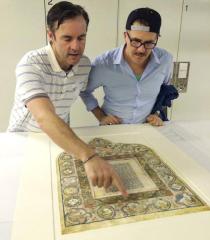
After surveying a range of fine art and ritual objects, Fallen Fruit found inspiration in an ornate Italian ketubbah dating back to 1677. In Jewish tradition, a ketubbah is a marriage contract signifying mutual commitment and partnership. Here, David Burns (left) and Austin Young (right) examine the manuscript.
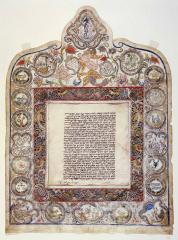
Made out of parchment (animal skin), the seventeenth-century ketubbah portrays five biblical scenes and is richly decorated with floral and animal motifs and twelve signs of the zodiac set in roundels. Text, 1677; border, eighteenth century. Ink, gouache, gold paint, and cutout on parchment.
Salli Kirschstein Collection. SCC34115
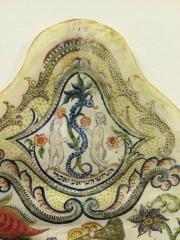
A close-up of the ketubbah is seen here. The biblical story of Adam and Eve is depicted as Eve extends her arm to pick a fruit that resembles a pomegranate.
Salli Kirschstein Collection. SCC34115

Fallen Fruit then designed and produced a special-edition pomegranate wallpaper just for the Skirball, pictured here upon being printed on self-adhesive vinyl. The artists’ fruit wallpaper has become their signature visual format for exploring fruits that are important or symbolic to certain institutions and collections.
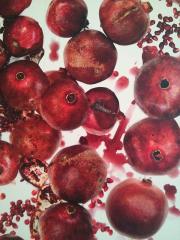
A close-up of the Skirball-edition wallpaper reveals that it portrays photographs of pomegranate fruits and seeds. In cultures worldwide, the pomegranate appears as a symbol of fertility and signifier of good relationships. Both the cultural ritual of marriage—especially in the context of contemporary struggles to achieve gender and marriage equality for all—and the symbolic meanings of the pomegranate are the inspiration for Fallen Fruit of the Skirball.
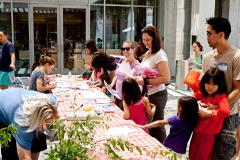
While the design and production of the wallpaper were underway, the artists and the Skirball hosted a special pomegranate tree adoption event in anticipation of the installation. Here, Skirball visitors excitedly sign tree adoption papers and receive caretaking instructions, promising to care for their tree for three years.
Courtesy of Fallen Fruit

This happy family was pleased to adopt a tree. In exchange for the tree, Burns and Young encouraged recipients to plant the pomegranate trees in a public space or along the borders of private property, where the fruits can be shared and enjoyed by the community.
Courtesy of Fallen Fruit

Skirball visitors of all ages came to adopt pomegranate trees.
Courtesy of Fallen Fruit
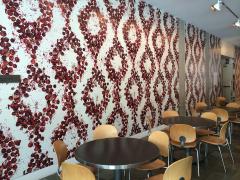
In May, Fallen Fruit’s specially designed wallpaper was installed in the Skirball’s Ruby Gallery, which was transformed by the repeating lattice-like pattern of pomegranates. But the installation didn’t end there. The exhibition evolved over time as Fallen Fruit added different visual elements on top of the wallpaper.
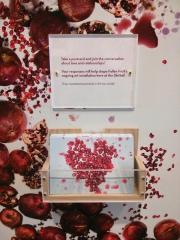
Using social media and an old-fashioned postcard campaign, Fallen Fruit engaged the public in answering a series of questions, including “What is the best ingredient for true love?” and “What is the most important thing your parents or grandparents taught you about love?”

Using social media and an old-fashioned postcard campaign, Fallen Fruit engaged the public in answering a series of questions, including “What is the best ingredient for true love?” and “What is the most important thing your parents or grandparents taught you about love?”

Fallen Fruit also collected submissions of portraits of people who love each other, whether couples, families, or friends, both past and present. Above is one of the submissions the artists received.
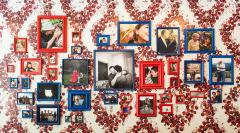
Fallen Fruit framed a selection of ninety portraits, images that span a lifetime. Many of the Skirball staff participated, as well as people from Los Angeles and beyond. The portraits were hung salon-style over the pomegranate wallpaper in late July.
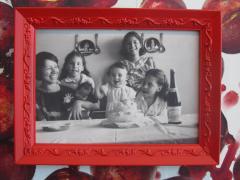
Here is a closer look at one of the framed public submissions. The images include families, newlyweds, couples celebrating anniversaries, grandparents and grandchildren, best friends, and a gay couple tying the knot on the day the Defense of Marriage Act was overturned.
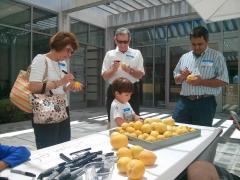
Fallen Fruit also held a Lemonade Stand at the Skirball, an ongoing Fallen Fruit project that offers each visitor a cold glass of lemonade in exchange for a self-portrait on a lemon! The visitors in this photo are hard at work on their self-portraits.

Here is a family posing with their lemon portraits at the Lemonade Stand.
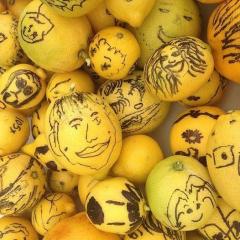
More than 100 lemon portraits were created at the event!

Finally, Fallen Fruit created this “Love Score,” a contemporary commitment document inspired by the 1677 ketubbah. The document was constructed by Fallen Fruit from the many public responses to their question “What qualities does it take to build a lasting relationship?” Three different voices—wisdom, reason, and guidance on everyday actions—operate as a set of instructions on how to love someone. For Fallen Fruit, the voice is a shared expression of what it means to love unconditionally.
Fallen Fruit, 2014
Watch this video to learn more about Fallen Fruit’s collaboration with the Skirball.